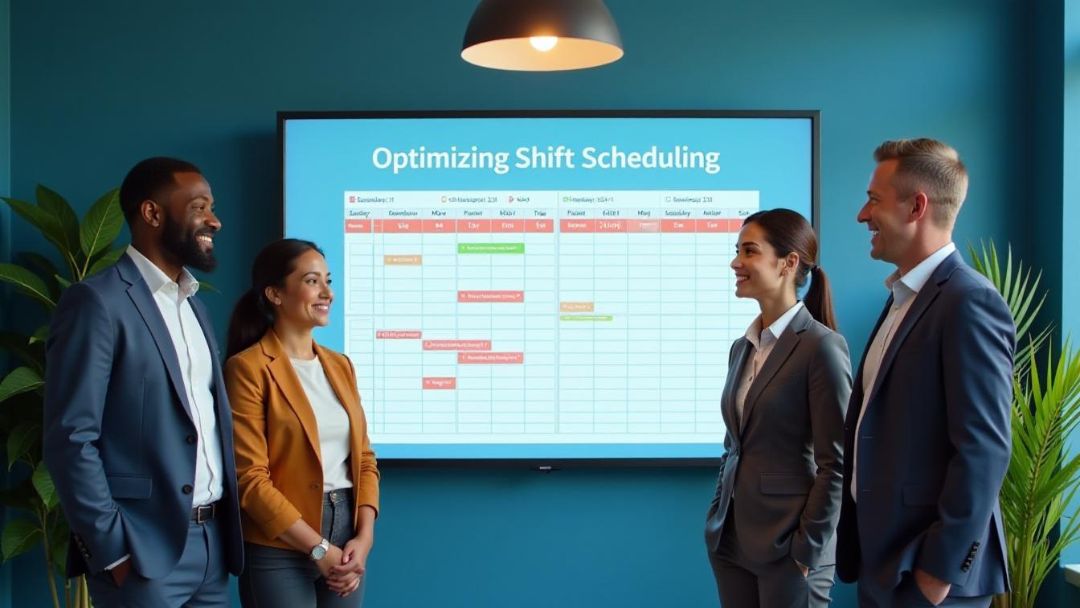Maximizing Efficiency in Healthcare: How Big Data Optimizes Workforce Management in Call Centers

Big data optimizes workforce management in call centers by enabling better staff allocation, real-time adjustments, and enhanced agent performance. This article will explore how big data optimizes workforce management in call centers through data-driven strategies that lead to improved efficiency, reduced costs, and higher customer satisfaction. Learn how predictive analytics, real-time monitoring, and data insights revolutionize call center operations.
Key Takeaways
- Predictive analytics enhances workforce planning by forecasting call volumes, leading to improved resource allocation and reduced agent burnout.
- Real-time monitoring and performance tracking tools enable immediate adjustments to staffing and coaching, improving operational efficiency and patient satisfaction.
- Data-driven insights help identify training needs and optimize scheduling, enhancing agent performance and reducing operational costs in healthcare call centers.
Enhancing Workforce Planning with Predictive Analytics

Utilizing predictive analytics has become a cornerstone for workforce management within healthcare call centers. By predicting forthcoming call volumes, these organizations can effectively distribute resources to handle busy intervals optimally. Predictive models provide the foresight necessary to ensure that an ample number of agents are available to address patient queries during surge periods. This approach does more than just enhance operational efficiency. It also mitigates risks associated with staff burnout and high turnover rates.
Cutting-edge analytics tools have revolutionized decision-making processes by empowering managers with data visualizations related to employee behavioral patterns, allowing them to fine-tune staffing schedules in alignment with anticipated demand levels. Such forecasting capabilities draw upon historical data as their foundation, granting supervisors the ability to tailor agent availability proactively rather than react belatedly—this fosters a consistently elevated standard of service while preempting potential disruptions.
Leveraging past performance and productivity metrics through predictive workforce analytics is crucial for foreseeing future outcomes in this space. Recognizing established patterns enables informed strategic choices regarding tech investments and how best to allocate company assets. Insights gathered from speech analytics or other analytical software are instrumental in perpetuating progress in both planning workflows and heightening customer engagement standards across the board.
Real-Time Monitoring and Adjustment
Monitoring tools that operate in real-time have revolutionized the way contact center operations are managed, providing supervisors with live insights into active calls and the agents’ navigation on their screens. This level of oversight promotes immediate mentoring and assistance, ultimately elevating the quality of interactions with patients. Through direct guidance, managers can aid representatives in settling patient concerns more effectively, which contributes to shorter call durations and boosts rates at which issues are resolved on the first attempt.
The practice of evaluating performance indicators as they happen is critical for enacting swift changes to both staffing levels and center operations. By leveraging analytics that capture data instantaneously, call centers can quickly adapt to changing volumes of incoming calls by adjusting workforce numbers accordingly. Such actions enhance operational efficiency while also improving patient satisfaction by minimizing waiting periods and heightening the likelihood of resolving queries during initial contact.
Rapid processing of this real-time information streamlines decision-making processes, Augmenting agility within call center operations. Persistent scrutiny coupled with alterations informed by live data sustains a high standard for service delivery along with efficient operation management. This synergy not only leads to reduced expenses but also yields improved outcomes for patients.
Improving Agent Performance through Data Insights

In the realm of healthcare call centers, the importance of data insights for enhancing agent performance cannot be overstressed. By employing big data analytics, these call centers are capable of gathering and scrutinizing a large spectrum of customer data to gain an extensive understanding of the patient experience. This all-encompassing view is instrumental in pinpointing opportunities for enhancement, culminating in superior service provision and heightened customer satisfaction.
Call center utilization of analytics tools serves as a catalyst for operational efficiency while fostering stronger patient connections and augmenting revenue streams. The application of data-driven insights facilitates customized strategy formulation and training initiatives that align with both agent abilities and patient necessities.
The subsequent discussion will delve into how discerning educational requirements and monitoring performance indicators are pivotal factors in the elevation of agent efficacy within this context.
Identifying Training Needs
Utilizing big data analytics can be instrumental in uncovering proficiency deficiencies within call center staff. By examining the details of call interactions, these centers are able to identify specific training or support needs for their agents. Such focused strategies guarantee that developmental programs tackle essential areas, thereby optimizing learning results and agent performance.
In healthcare call centers where consistent, high-quality service is imperative, ongoing advancement and education are crucial. As advancements continue in big data analytics tools, it’s important for agents to stay abreast of how to apply these resources proficiently. Regular training commitments ensure personnel maintain expertise in deploying analytics technologies effectively to elevate the quality of patient communication and overall service delivery.
Performance Metrics Tracking
Monitoring essential key performance indicators (KPIs) is crucial for evaluating the efficiency and productivity of both call center operations and agents. Metrics such as first call resolution (FCR), average handle time (AHT), and rates of call abandonment provide critical insights into operational effectiveness and quality of service. Consistent tracking of these KPIs enables contact centers to refine their strategies dynamically, leading to ongoing improvements that boost contact center performance.
The use of analytics software, along with speech analytics, plays a pivotal role in analyzing factors that influence average handle time, among other vital metrics. Such tools are instrumental in pinpointing where bottlenecks occur operationally, paving the way for improvement initiatives within call centers aimed at boosting agent performance and enhancing customer satisfaction through advanced natural language processing techniques.
By capitalizing on historical data coupled with customer surveys, contact centers can achieve a more profound understanding of customer behavior patterns. This knowledge facilitates tailored interactions that are not only more effective but also resonate better with customers’ needs and expectations.
Optimizing Shift Scheduling

Maximizing the effectiveness of shift scheduling is an essential component in managing personnel within healthcare call centers. By harnessing machine learning and leveraging data-driven insights, these call centers can detect trends within their call data to arrange shifts that coincide with peak calling periods. This approach secures sufficient staff coverage during times of high call volumes, fostering enhanced efficiency in handling calls and diminishing patient wait times.
Instituting intelligent scheduling protocols bolsters operational efficiency while simultaneously elevating employee contentment and minimizing agent weariness. Utilizing a strategy informed by empirical data ensures equitable distribution of workload, thereby reducing the risk of burnout and attrition among agents.
Ongoing refinement of staffing schedules through predictive analytics empowers call centers to uphold exceptional service standards alongside safeguarding the welfare of their agents.
Reducing Operational Costs

Trimming operational expenses remains a key goal for healthcare call center operations, which seek to elevate efficiency and the standard of services offered. Through data analytics, potential areas where savings can be made are pinpointed and optimized within the context of call center activities. By scrutinizing how calls are managed and pinpointing wasteful practices, call centers can develop plans that meaningfully slash operational costs.
Implementing an adept optimization strategy brings about decreased stress levels for agents as well as lower turnover rates while enhancing workforce management and boosting success in resolving calls. Big data analytics empowers call centers to refine their procedures, resulting in decreased expenditures along with increased satisfaction amongst patients.
Adopting this forward-thinking tactic in cost supervision allows call centers to uphold excellent service delivery without compromising on fiscal responsibility—assuring ongoing high-quality interactions backed by quality data insights.
Enhancing Patient Experience
In the realm of healthcare call center operations, the pivotal objective is to elevate the patient experience. The integration of big data analytics into call center practices provides a profound insight into patients’ desires and necessities, enabling tailored and impactful communication. Predictive analytics is instrumental in predicting workforce needs and refining staff allocation to enhance overall patient satisfaction.
At the core of improving customer experience within call centers are two essential factors: individualized engagement with patients and diminution of waiting periods. Prioritizing these elements can markedly boost patient satisfaction ratings while cultivating deeper allegiance from them.
Personalized Patient Interactions
Enhancing patient experience hinges on the personalization of their interactions. Valuable data acquired by call centers through feedback, surveys, and recorded interaction histories provide a wellspring of information. This data is processed using text and speech analytics within contact centers to discern patient sentiments and preferences, shedding light on trends and pinpointing opportunities for improvement.
By harnessing analytical insights, agents are equipped to foresee patients’ needs and customize their communication accordingly. This leads to exchanges that are not only more impactful but also more efficient in nature. Transforming raw data into actionable insights by adopting best practices empowers the enhancement of interaction quality while simultaneously elevating customer satisfaction levels.
Call centers committed to personalized engagement with customers can forge robust relationships with patients, which foster heightened loyalty and contentment among them. This personalized attention doesn’t just elevate individual experiences—it’s instrumental in bolstering the overarching success rate of the contact center itself.
Reducing Wait Times
In the healthcare industry, keeping wait times to a minimum is critical for sustaining high levels of patient satisfaction within call centers. It’s vital to maintain an abandonment rate below the industry standard of 10% in order to retain patient engagement. Employing root cause analytics can aid in decreasing both the number and duration of interactions, which contributes to a more streamlined handling of calls.
By implementing intelligent self-service options, hold times and abandonment rates can be significantly reduced as patients receive rapid and precise information. Utilizing big data for advanced call routing amplifies operational efficiency by ensuring that patients’ concerns are promptly addressed by the most appropriately skilled agents.
Call centers must persistently fine-tune these mechanisms with an aim to bolster patient contentment while elevating the caliber of their service offerings overall.
Ensuring Data Quality and Security

Maintaining high standards of data quality and security is critical in healthcare call centers. Employing secure systems that meet industry guidelines helps to shield confidential patient information from potential breaches and unwarranted access attempts. By imposing strict controls on who can access the data based on their job requirements, we can significantly improve our safeguard against unauthorized exposure.
Periodic security evaluations are essential for discovering and rectifying any weaknesses within the system, thus fortifying defenses around patient information. Encrypting both communication exchanges and stored patient data adds an additional layer of protection to this privacy framework.
Compliance with legal frameworks such as GDPR and HIPAA is imperative for upholding the integrity of patient data while securing the trust of those we serve. Informing patients about how their personal details are protected promotes understanding between them and enhances collaboration toward preserving their privacy rights.
Overcoming Challenges in Big Data Implementation
The incorporation of big data analytics into healthcare call centers is accompanied by distinctive challenges. Ineffective analysis of call data can stem from antiquated telephone systems, which obstruct the extraction of actionable insights due to issues such as system integration difficulties, a lack of necessary skills, and an excessive amount of center data.
To navigate these hurdles, it may be imperative to either invest in upskilling current employees or recruit seasoned data scientists. Engaging with experts in external data analytics services might also prove beneficial for filling substantial expertise gaps and enhancing the utilization of insights.
Employing apt technological tools along with instituting a framework that prioritizes certain aspects within analytics is crucial for surmounting these obstacles. This approach ensures informed decision-making grounded on comprehensive evaluations derived from call center information.
Sequence Health
Established in 2002, Sequence Health has earned its reputation as a reliable ally for healthcare entities. The company excels at offering services such as website design, search engine optimization, digital marketing, and managing social media platforms. These offerings are crafted to bolster patient engagement and elevate conversion rates for medical practices, clinics, and hospitals.
By harnessing various communication channels and refining the customer journey experience, Sequence Health guarantees efficient call routing that enhances interactions with patients and boosts their overall satisfaction.
Dedicated to pioneering advancements and upholding superior standards of service delivery, Sequence Health stands out as a solid partner for healthcare-focused call centers intent on optimizing operational effectiveness while ensuring high levels of patient satisfaction.
Summary
The employment of medical call center services within healthcare call centers has transformed the management of their workforces, culminating in marked enhancements in both operational efficiency and patient satisfaction. Utilizing predictive analytics for forecasting, coupled with real-time monitoring and insights derived from data, these call centers are poised to refine staffing levels, bolster agent performance, and slash operating expenses.
Looking ahead to what’s coming next, it is clear that the continued embrace of big data analytics will propel even more progress within healthcare call centers. Organizations that adopt these innovative technologies and methodologies position themselves to deliver unparalleled service quality to patients—strengthening loyalty while heightening overall satisfaction.
Frequently Asked Questions
How does predictive analytics help in workforce planning for healthcare call centers?
Predictive analytics enhances workforce planning in healthcare call centers by accurately forecasting call volumes, enabling optimal resource allocation and readiness for peak demand.
This leads to improved operational efficiency and better service delivery.
What are the benefits of real-time monitoring in call centers?
By utilizing real-time monitoring, call center efficiency is boosted as it allows for instantaneous coaching of agents, better optimization of patient communications, and the ability to make quick changes in both staffing and operational procedures.
As a result, this enhancement in center performance significantly elevates customer satisfaction due to improved service effectiveness.
How do big data analytics improve agent performance in call centers?
Big data analytics enhance agent performance in call centers by offering insights that identify skill gaps and monitor key metrics, ultimately facilitating targeted training and improving service delivery.
What measures can call centers take to ensure data quality and security?
To ensure data quality and security, call centers should utilize secure platforms, implement strict access controls, conduct regular security audits, and adhere to regulations such as GDPR and HIPAA.
This comprehensive approach will safeguard sensitive information effectively.
What challenges do call centers face when implementing big data analytics, and how can they overcome them?
Call centers face challenges like outdated systems, integration issues, and skill gaps when implementing big data analytics. They can overcome these obstacles by investing in staff training, hiring data scientists, collaborating with external experts, and utilizing appropriate technology tools.





